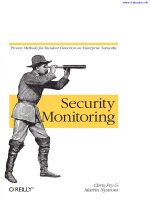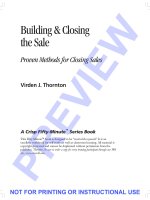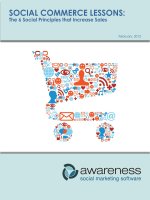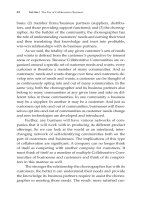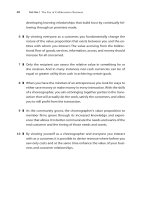BUILDING & CLOSING THE SALE - PROVEN METHODS FOR CLOSING SALES docx
Bạn đang xem bản rút gọn của tài liệu. Xem và tải ngay bản đầy đủ của tài liệu tại đây (485.51 KB, 18 trang )
Building & Closing
the Sale
Proven Methods for Closing Sales
Virden J. Thornton
This Fifty-Minute™ book is designed to be “read with a pencil.” It is an
excellent workbook for self-study as well as classroom learning. All material is
copyright-protected and cannot be duplicated without permission from the
publisher. Therefore, be sure to order a copy for every training participant through our Web
site, www.courseilt.com.
A Crisp Fifty-Minute
™
Series Book
PREVIEW
NOT FOR PRINTING OR INSTRUCTIONAL USE
ii
Building & Closing the Sale
Proven Methods for Closing Sales
Revised Edition of Closing: A Process, Not a Problem
Virden J. Thornton
Credits:
Product Manager: Debbie Woodbury
Editor: Charlotte Bosarge
Manufacturing: Julia Coffey
Production Artists: Nicole Phillips, Rich Lehl, and Betty Hopkins
Cartoonist: Ralph Mapson
COPYRIGHT © 1995, 2001 Axzo Press. All Rights Reserved.
No part of this work may be reproduced, transcribed, or used in any form or by any means—graphic, electronic, or
mechanical, including photocopying, recording, taping, Web distribution, or information storage and retrieval
systems—without the prior written permission of the publisher.
Visit us online at www.courseilt.com
Trademarks
Crisp Fifty-Minute Series is a trademark of Axzo Press.
Some of the product names and company names used in this book have been used for identification purposes only
and may be trademarks or registered trademarks of their respective manufacturers and sellers.
Disclaimer
We reserve the right to revise this publication and make changes from time to time in its content without notice.
ISBN 10: 1-56052-598-3
ISBN 13: 978-1-56052-598-1
Library of Congress Catalog Card Number 00-106651
Printed in the United States of America
7 8 9 10 09 08 07
PREVIEW
NOT FOR PRINTING OR INSTRUCTIONAL USE
iii
Building & Closing the Sale
Learning Objectives For:
BUILDING & CLOSING THE SALE
The objectives for Building & Closing the Sale are listed below. They have been
developed to guide the user to the core issues covered in this book.
THE OBJECTIVES OF THIS BOOK ARE TO HELP THE USER:
1) Increase the chances of consistently successful sales by building
rapport and trust
2) Learn how to address questions and objections with confidence
3) Tailor the sales demonstration to each client
4) Ask the right questions and keep your prospect’s attention
ASSESSING PROGRESS
A Crisp Series assessment is available for this book. The 25-item, mul-
tiple-choice and true/false questionnaire allows the reader to evaluate his
or her comprehension of the subject matter.
To download the assessment and answer key, go to www.courseilt.com
and search on the book title.
Assessments should not be used in any employee selection process.
PREVIEW
NOT FOR PRINTING OR INSTRUCTIONAL USE
iv
Preface
I periodically receive books from publishers across the country to review on
“selling techniques” and “closing skills.” In these books, the authors often list
dozens of different closing tools or “tactics,” as one writer calls them. Many of
these closing methods are extremely high pressure and manipulative. Most of the
phrases and questions suggested for closing sales are completely unusable today.
Is it surprising then that sales representatives and service industry professionals
(accountants, bankers, attorneys, engineers, etc.) fear closing? If high-pressure—
and in many cases ethically questionable—closing techniques are all that a profes-
sional is taught, it is easy to see why closing a sale can be difficult.
Closing a sale is an ethical process that anyone can learn. The selling process
outlined in this self-administered learning guide is designed to alleviate the fear of
making presentations and closing sales, and encourages alternative methods to
high pressure and manipulation of prospective customers or clients. Once you
have mastered the steps described here, you should never have to pressure or
manipulate a prospect to buy from you again. Good luck.
Virden J. Thornton
Dedication
To Marion D. Hanks, a special teacher and leader who changed my life.
To my wife, Barbara, for her love and devotion.
PREVIEW
NOT FOR PRINTING OR INSTRUCTIONAL USE
v
Building & Closing the Sale
About the Author
As founder, president, and senior advisor at The Selling Edge
®
, Inc., a training
and development firm in Avon Lake, Ohio, Virden J. Thornton has assisted
thousands of managers, sales representatives, and service industry professionals
(accountants, attorneys, bankers, engineers, etc.) in generating more business for
their organizations. A partial client list includes AvFuel; Eastman Kodak; PNC
Bank; Jefferson Pilot; National Associates, Inc.; the government of the U.S.
Virgin Islands; Service Linen Supply, Inc.; IBM; Bolanis Financial Planning
Group, Inc.; City Laundering Co; New York Life; and Wal-Mart. Virden is the
author of an acclaimed self-directed learning series of sales, telemarketing, and
motivational guides. He is also the author of Prospecting: The Key to Sales Success and
Close That Sale, an audio/videotape program by Crisp Publications. He is a dy-
namic national speaker and regularly conducts workshops on sales, coaching,
and team development, customer service, and motivational topics. Virden and
his wife, Barbara, are the parents of 10 children.
PREVIEW
NOT FOR PRINTING OR INSTRUCTIONAL USE
vi
Contents
Part 1: Building Rapport
Closing: An Essential Part of the Selling Process 3
Rapport = Trust 8
Pre-Interview Trust Builders 9
Communication Techniques that Build Trust 20
Opportunity: A Favorable Juncture of Circumstances 23
Finding Something in Common Is a Myth 32
Part 2: An Ethical Approach to Closing Success
Uncovering Prospects’ Needs 37
Ask a Provocative Question 41
To Obtain the Keys to Fort Knox, Use a Take-Away Transition 44
Avoid the Product or Service Trap 46
Part 3: Ask In-Depth, Probing Questions
Producing Profitable Interactions 51
1. Ask Open-Ended Questions 52
2. Phrase Questions Carefully 54
3. Rephrase and Redirect to Maintain Control 56
4. Deal with Negatives Head-On 58
5. Use the Most Powerful Principle in Communications 61
PREVIEW
NOT FOR PRINTING OR INSTRUCTIONAL USE
vii
Building & Closing the Sale
Part 4: Demonstrations That Close
The Demonstration Phase of Closing 65
Appeal to Your Prospect’s Emotions 70
Three Important Rules 71
Give Intellectual Proof 72
Ask Trial Closing Questions 79
Answer Objections as Questions, Not as a Roadblock to Your Sale! 81
Beginning the Close 84
Part 5: Closing Is a Process
Finalizing Your Sale 93
Recognizing Buying Signals 96
Create a Sense of Urgency 98
Just Ask! 100
Summary 102
Additional Reading 103
PREVIEW
NOT FOR PRINTING OR INSTRUCTIONAL USE
viii
PREVIEW
NOT FOR PRINTING OR INSTRUCTIONAL USE
PART
Building
Rapport
1
PREVIEW
NOT FOR PRINTING OR INSTRUCTIONAL USE
2
PREVIEW
NOT FOR PRINTING OR INSTRUCTIONAL USE
3
Building & Closing the Sale
Closing: An Essential Part
of the Selling Process
The ultimate goal in any selling activity is to tie down the sale. However, closing
a sale is difficult for most sales representatives or service industry professionals,
often causing many of them to lose sight of this vital objective. For example, one
national study on sales communication showed that in over 60% of the sales
meetings conducted daily, there is no attempt on the part of the seller to close a
sale. Some marketing executives estimate that as many as 50% of all sales repre-
sentatives and licensed professionals quit after their first sales meeting, and fewer
than 12% percent persist until a buyer finally says “yes.” As these studies illus-
trate, you must learn the art of asking for business, or your chances of consis-
tently selling your products or services (getting your prospective buyer to take
action) will be reduced significantly. Nevertheless, one of the most overrated
topics in sales training today is the subject of closing.
The object of most sales courses is to fill the heads of participants with as many
closing techniques as possible. More than half of most workshops or seminars
will address closing skills. The logic is simple—if the “Ben Franklin” close does
not work, the participant is then taught to rummage around in his or her head
for the “puppy dog,” “secondary question,” “order-blank,” or “forced choice”
close to tie off the sale. (“Forced choice”—now that sounds ethical, doesn’t it?)
Today, sales training in many business or professional organizations—if it exists at
all—is simply teaching participants about the company’s products or services,
then drilling them on how to make a “pitch” and memorize a long and complex
series of closing techniques. In contrast to this methodology, top sales profession-
als know that successful selling and closing is part of an overall process and not
just the use of hard-sell presentation and closing techniques. They know that if
you can learn to show your prospects, customers, or clients that they are better
off using your products or services, then the sale is yours.
PREVIEW
NOT FOR PRINTING OR INSTRUCTIONAL USE
4
Closing: An Essential Part of the Selling Process (CONTINUED)
When a sales presentation is made properly, the natural conclusion to the trans-
action is to close the deal. Most buyers expect to be asked to take action when
your sales presentation is followed to its natural conclusion. At this point in a
sale, you do not need to use special closing techniques—you simply need to ask
for the business.
Closing is actually the easiest part of the selling process. However, most sales
representatives and professionals do not believe that closing is easy, because most
of today’s sales training, as suggested above, teaches the closing process back-
ward. If today’s sales training models were diagrammed as a triangle, building
relationships with prospective customers or clients would be the little point of the
triangle. Teaching prospects about sales presentations products and how to
present them would be a broad band in the middle of the illustration, and tech-
niques for closing the sale would be the large base of the triangle.
Using a marriage proposal as an analogy, marketing professional Steven Brown
in American Salesman* suggests that the emphasis on presentation and closing skills
puts the sales or service industry professional in the position of a suitor in Victo-
rian England. “He has barely met the girl, but convention demands that he
propose marriage before he can get to know her. He uses a well-rehearsed speech
to try to persuade her of his worthiness. He has no idea of whether his attention
is welcome or utterly inappropriate. He’s terrified because everything hinges on
her ‘Yes’ or ‘No.’”
An effective closing process turns the sales pyramid upside down, with the small
point at the bottom. Closing should follow a pattern similar to today’s marriage
proposal. “Will you marry me?” is most often no more than a rhetorical ques-
tion, of which both suitors should know the outcome, provided they have a well-
established relationship. As Brown suggests, “When he asks for her hand (or
when she pops the question), he’s pretty sure of getting a ‘yes.’” Closing a sales
transaction the right way is a natural outcome of a relationship that is built on a
foundation of mutual respect and trust.
*Excerpts reprinted with permission of © National Research Bureau, P.O. Box 1, Burlington, Iowa 52601-
0001.
PREVIEW
NOT FOR PRINTING OR INSTRUCTIONAL USE
5
Building & Closing the Sale
Closing a sale is an integral part of an orchestrated selling process. By first build-
ing rapport with your prospect, you create the trust that is vital to closing a sale.
No matter how wonderful your product or service is, people will not buy from
you unless they trust you! By learning to ask closed-ended, attention-getting
questions, you can open your prospect’s mind to ultimately accepting your
presentation. Open-ended, probing questions can then be asked to learn about
needs, hidden feelings, and problems that can be solved by the specific products
or services that you represent. By tailoring your demonstration to only those
products or services that meet the needs or problems you uncover in your ques-
tioning, and by asking trial closing questions, you can determine how your
prospect feels about your presentation and the suggested solution to your
prospect’s problems. Then, by answering any questions or objections your
prospect might have, you can set the stage for tying off the transaction. All that is
left in the closing process is to simply ask for the business.
PREVIEW
NOT FOR PRINTING OR INSTRUCTIONAL USE
6
Closing: An Essential Part of the Selling Process (CONTINUED)
This self-directed learning tool explores the steps in the selling process that lead
to a successful close. You will not be given a dozen closing speeches to memorize.
Nor will you receive a long list of power words to compel your prospect to sign
on the dotted line. These often questionable tactics simply do not work with
today’s sophisticated consumers. If you learn and review the steps to closing a
sale that are presented here, then apply them in your daily sales activities, you
should begin to see a significant difference in your ability to generate business for
your organization.
All you need to do is execute the steps or stages of the selling (closing) process
properly, and the close will take care of itself. Remember that closing is an inte-
gral part of the selling process, not a stand-alone technique. An effective closing
process looks something like this:
The Closing Pyramid
Step 1: Build Rapport
Step 2: Capture Your Prospect’s Attention
Step 3: Probe for Problems, Opportunities, Needs,
Values, Attitudes, and Lifestyles
Step 4: Demonstrate Your Products or Services
Based on Specific Needs
Step 5: Ask Trial Closing Questions
and Answer Objectives
Step 6: Ask for the Sale
PREVIEW
NOT FOR PRINTING OR INSTRUCTIONAL USE
7
Building & Closing the Sale
SELF-ASSESSMENT
Before you go any further, take a few minutes to answer the following
questions.
How does your business success compare to projections from a year ago?
___________________________________________________________________
___________________________________________________________________
___________________________________________________________________
Are you meeting your goals? If not, how far off are you?
___________________________________________________________________
___________________________________________________________________
___________________________________________________________________
What specific closing problems do you have?
___________________________________________________________________
___________________________________________________________________
___________________________________________________________________
What do you believe is your biggest barrier to successful closing?
___________________________________________________________________
___________________________________________________________________
___________________________________________________________________
Keep your answers in mind as you read on. This will help you stay focused on
getting the most value from this book.
PREVIEW
NOT FOR PRINTING OR INSTRUCTIONAL USE
8
Rapport = Trust
When Joe Gandolfo, a life insurance salesman from a small town in Florida, was
asked how he had closed over $1 billion of life insurance in a single year, he said
that it was simple—“all it takes is understanding people.” Although Joe’s response
may seem simplistic, his formula can be recommended without hesitation—
because it works. In addition, it can work as well for you as it did for Joe
Gandolfo or for any other successful sales representative or licensed professional.
In the insurance industry, members get excited about someone who sells in
excess of $1 million of life insurance each year. They have an elite group of sales
professionals who belong to a Million Dollar Round Table. The Round Table is
where individuals are recognized for outstanding sales performance. To put Joe’s
accomplishment in perspective, it would take an average Million Dollar Round
Table producer 1,000 years to equal Joe Gandolfo’s one-year production figures.
Joe’s level of closing is remarkable. He is one of a distinguished group of sales
superstars who has discovered the secret of consistently closing sales. Therefore,
when Joe suggests that consistent closings depend on your “ability to understand
people,” rather than presentation skills, technical ability, or product knowledge,
you should pay attention to him. The most important skill in closing is the ability
to understand the people you serve and then, through this understanding, build
rapport with them. Building rapport is the method top sales and service industry
professionals use to develop a feeling of trust in the people they serve. Without
trust, buyers will not actively participate in the closing process. Always remem-
ber, people buy from a professional whom they trust. So, what do you have to do
to build trust? Read and follow the recommendations in this section of the
manual.
CLOSING PRINCIPLE
1
People buy from people they trust.
PREVIEW
NOT FOR PRINTING OR INSTRUCTIONAL USE
9
Building & Closing the Sale
Pre-Interview Trust Builders
Dress for Success
Looking professional means wearing appropriate attire. If you suspect you might
be weak in this area, get a book on the subject of professional dress from your
local library. John Molloy’s books, John T. Molloy’s New Dress for Success or Women’s
Dress for Success Handbook, both provide helpful information on appropriate dress
for your industry. Although these books are difficult to find, most large metro-
politan-area or college libraries have copies in their business sections. In addition,
your favorite bookstore may still be able to obtain copies, or you can check
online at Barnes & Noble or Amazon.com. John Malloy’s recommendations are
still valid today because they are based on solid research into how people per-
ceive you, based on the clothes you wear and not simply on how some guru
thinks your appearance will affect other people from an aesthetic standpoint.
Remember, little things like facial hair, tattoos, and piercings can reduce your
ability to build rapport and close sales by as much as 30%. Ask, “Is a beard or
several gold rings or studs really worth the lost revenue?” To judge a book by its
cover may not be fair, yet nearly everyone does. Even when people mentally tell
themselves not to be hasty in judging others, they still register opinions about
another person based on how the individual looks, moves, and dresses. These
quick mental judgments are influenced by two important factors—body language
and personal appearance. Appearance includes clothing, accessories, hair, skin,
makeup, and grooming (cleanliness, body odor, nail care, etc.).
PREVIEW
NOT FOR PRINTING OR INSTRUCTIONAL USE
10
CASE STUDY: FIRST (AND LAST) IMPRESSIONS
If you don’t think people base their opinion on how you dress, an article
published on the front page of USA Today clearly illustrates how susceptible
we are to making invalid judgments based on appearance.
John Barrier, dressed in dirty construction clothes, walked into his bank
to cash a check for $100. When he presented the check, he also asked that
his parking slip be validated to save 60 cents. A bank employee refused to
validate the ticket since the customer had not conducted a required deposit
transaction. When he informed the employee that he was considered a sub-
stantial depositor of the bank, she looked at him as though she did not
believe a word he said. He received no better treatment from the manager,
who, in Mr. Barrier’s words, looked at him as though he had “crawled out
from under a rock” because of the way he was dressed. The next day, John
Barrier withdrew $1 million from this bank. Who would have believed,
based on his appearance, that this man was a multimillionaire?
Your appearance is a power tool that can be used to influence others
positively or negatively. As you mentally evaluate people, they are judging
you in the same way. How you look, move, and dress influences everyone
with whom you interact—your prospects, customers or clients, co-workers,
friends, relatives, even strangers. You must recognize the power of the first
impression if you expect to consistently close sales.
Psychologists and behaviorists report that when a person dresses more
professionally, he acts more professionally as well. You have the ability to
create a powerful image of confidence, competence, and professionalism,
which in turn will build trust in your potential customers (clients). As a rule,
you should always dress one level above your prospect, customer, or client
to make a favorable impression and build the kind of trust that leads to
closing the sale.
PREVIEW
NOT FOR PRINTING OR INSTRUCTIONAL USE

